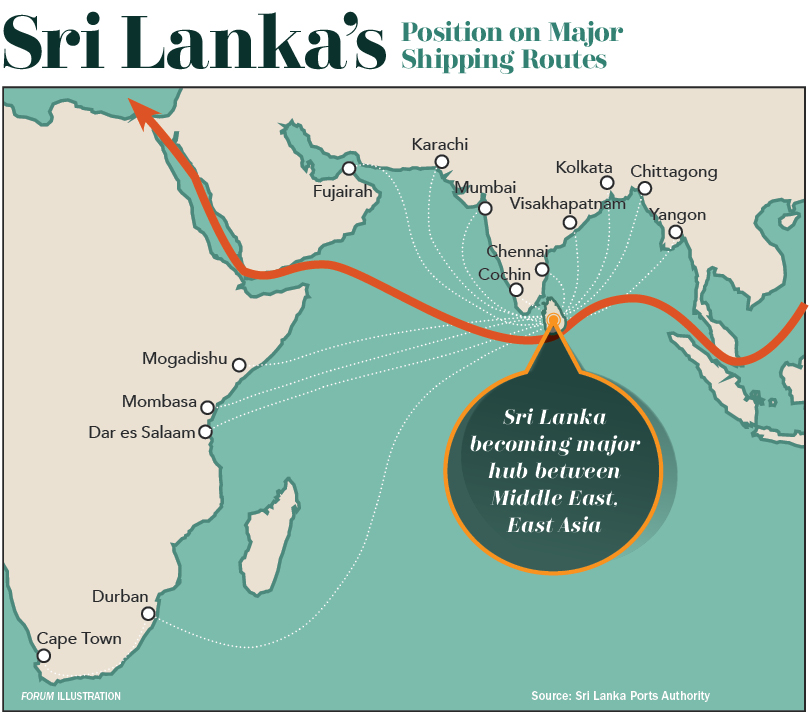
“Along with challenges come opportunities”, assures Saroja Sirisena, Sri Lanka’s High Commissioner in the United Kingdom. And though it can be argued that this is a known fact, it has never seem so poignant as it does now in our post-pandemic world. Like all countries, Sri Lanka is recovering from the particular economic challenges posed by the COVID-19 pandemic, but unlike many it possesses huge strategic potential to become one of the main hubs for international investors in South Asia and beyond.
With a thriving tourism and hospitality industry that contributes around half a million jobs, as well as a large expatriate population, it is no surprise Sri Lanka was extremely vulnerable to the spread of the virus. The challenges posed by a strict island-wide lockdown, the temporary suspension of commercial flights, finding sufficient medical equipment and procuring vaccines were deeply felt, but the overall efficiency of the health sector and the high quality of its services prior to the crisis contributed to minimize the pandemic’s negative effects and speed up the island’s recovery.
As of August 2020, Sri Lanka was the South Asian country that most successfully controlled COVID-19, with 2,839 reported cases for its 21 million inhabitants.
One of the first measures taken by president Gotabaya Rajapaksa’s government was the creation of the National Operation Center for Prevention of COVID-19 to ensure that healthcare and essential services were provided to the general public in an efficient manner. Later on other opportune measures were developed, most notably the establishment of the ‘ITUKAMA’ COVID-19 Healthcare and Social Security Fund, in order to address the critical healthcare needs of those affected by the virus and to improve Sri Lanka’s long-term preparedness for health emergencies. Consequently, those initial measures started to yield results, and as of August 2020, Sri Lanka was the South Asian country that most successfully controlled COVID-19, with 2,839 reported cases for its 21 million inhabitants. Afterwards, as new waves of the virus began to appear worldwide the number of local cases spiked, but renewed efforts were implemented and nowadays the vaccination programme is running smoothly and the restrictions imposed by the government have managed to curb the spread of the virus.
An open-minded and highly strategic foreign policy
Moreover, such long-term, efficiency oriented and strategic perspective has not been limited to the coronavirus response. It has in fact been one of Rajapaksa government’s staples. One of the areas where this is most evident is in the management of its foreign policy. Leaving behind a long and costly civil war that ended in 2009, Sri Lanka’s government has focused instead on developing its foreign relations under a non-aligned policy that allows them to work with all friendly nations on equal terms. As High Commissioner Saroja Sirisena openly states, “simply our policy is friendship with all and enmity with none”.
This open perspective has allowed them to strengthen its economic relations on a wide and diverse scale. On the one hand, it has meant focusing on developing long-term, strong and reciprocal commercial ties and trade relationships with their Asian neighbours, China in particular, as economic power is now shifting towards Asia and China’s global investments surpass any other single country’s investment in the world. On the other hand, such focus has not deviated Sri Lanka’s efforts in maintaining its solid economic relationship with the United States. Not only the US is Sri Lanka’s largest export destination with more than USD 2.5 billion in 2020, it is also home to a large Sri Lankan diaspora that actively contributes to both country’s economies. This open-minded business strategy is best expressed in Mrs. Sirisena direct approach: “our trade relations with the US are as important as the investment opportunities from China”.
While the economic relationship between Sri Lanka and China is centuries old, and it is worth noting that in 1952 Sri Lanka was the first country outside the Communist bloc to enter a trade agreement with China, this is by no means the only historically strong relationship it has nurtured. Being a founding member of the Commonwealth, the ties between Sri Lanka and the United Kingdom also have a long and robust standing. Apart from being the second largest export destination of Sri Lanka, the UK is also significant in terms of tourism. To further illustrate this point, in 2019 the UK was recorded as the second major country of origin for tourists with a share of 10.4%.
Sri Lanka’s government has embraced Brexit as “an opportunity to enhance our relations with the UK and the EU as two separate entities”
Significantly, Sri Lanka’s government feels that the special ties that bonds them with the UK don’t have to be threaten or affected by Brexit. Quite the opposite. Instead of perceiving it as a restrictive situation, Sri Lanka’s government has embraced it as “an opportunity to enhance our relations with the UK and the EU as two separate entities”. Therefore, even though Sri Lanka lost the GSP+ facility from the UK with Brexit, the UK offered ‘an enhanced framework’ that is similar to GSP+ and could open the way to new business models. “We believe that we need to explore avenues to sign a free trade agreement with the UK”, says High Commissioner Sirisena, adding that Brexit may lead to greater focus on strengthening the Commonwealth as well. There is no doubt that being an extremely diverse grouping of nations, a renewed focus on improving economic ties between members would indeed provide lucrative opportunities for Sri Lanka.
Brexit also provides an opportunity to consolidate their relations with large European powers like Germany, Spain, France and Italy where there is a huge Sri Lankan diaspora and with whom they share strong ties. And while the relationship between the EU and Sri Lanka is governed by a comprehensive Cooperation Agreement on Partnership and Development that dates back to 1995, for the Sri Lankan government the time is ripe for expansion and innovation: “it is essential to reach out to other EU countries, to identify markets other than apparel and conventional export items like tea and rubber, and to find out the potential in producing the rest of the products that receive GSP+”.
Currently exploring new ventures, Sri Lanka missions in the EU region are interested in engaging more with local trade institutes to understand the trends in local demands as well as taking advantage of fair trade to its full potential. “Since there is a huge demand for organic products in the European region, we can invest more in organic products while benefiting from fair trade”, says Mrs. Sirisena. Moreover, she believes that along with organic products Sri Lanka should also try exploring the possibility of exporting exotic tropical vegetables and fruits. Ultimately, while ensuring that UK’s investments in Sri Lanka are secured, the country is also interested in attracting more investments from other EU countries.

Post-pandemic foreign investment in Sri Lanka
While a focus on expanding their export market is key, the government of president Gotabaya Rajapaksa understands that it is as crucial to attract foreign direct investments into the country to stabilize key economic indicators. Although some of these were severely affected by the pandemic, the government believes that once restored they will allow the country to realize its potential as the next major investment haven in South Asia. Among them, it is worth noting that Sri Lanka ranked first in South Asia for Human Capital Skills, second in the region for Quality of Infrastructure and for Starting a Business / Doing Business 2020, and it was also recognized as the second largest CIMA pool in the world. Additionally, Sri Lanka has signed Bilateral Investment Protection Agreements (IPA) with 28 countries and has 1Bn access to neighboring economies with fast growing populations, potentially increasing exports through Sri Lanka’s Bilateral and Preferential trading arrangements with the region.
Sri Lanka ranked first in South Asia for Human Capital Skills, second in the region for Quality of Infrastructure and for Starting a Business / Doing Business 2020, and it was also recognized as the second largest CIMA pool in the world.
Likewise, in terms of lifestyle Sri Lanka has achieved some impressive mentions. Not only it was ranked first in South Asia for Quality of Life Index – 2019 and first for “Travel Destination” by Lonely Planet in 2019, it also has the lowest power cost in South Asia as per JETRO Survey 2019 and is projected to have a three times growth in number of graduates by 2025.
Sri Lanka benefits from being at the crossroads of major global shipping lanes. Particularly interesting when attracting foreign investments is Sri Lanka’s potential as a gateway to India, and more specifically to South India, which is the world’s fastest growing economic bloc at scale with a population of 300mn and annual GDP growth of 8%.
Furthermore, because of its strategic location, Sri Lanka benefits from being at the crossroads of major global shipping lanes. Particularly interesting when attracting foreign investments is Sri Lanka’s potential as a gateway to India, and more specifically to South India, which is the world’s fastest growing economic bloc at scale with a population of 300mn and annual GDP growth of 8%. And while currently Sri Lanka already handles nearly 50% of India’s international cargo volume, it is important to note that over the next 15 years the world’s ten fastest growing cities will all be in India, with five of them in South India, thus strengthening Sri Lanka’s proximity advantage and underscoring its market-access attractiveness to foreign companies. Similarly, Sri Lanka is emerging as a meaningful link in China’s Belt and Road initiative, and is poised to benefit significantly via the accelerating trade growth and associated investment projects in that channel.
According to Sri Lanka’s Bank of Industry, the five priority areas of Foreign Direct Investment are manufacturing, ICT, tourism, agriculture/food processing and construction/infrastructure. Manufacturing is concentrated on pharmaceutics with a local pharma market of USD 700mn, growing at 8-10% CAGR (85% is imported), as well as textile manufacturing and high value added apparel like electronics and electrical. On the other hand, ICT is one of Sri Lanka’s most exciting industries, with current exports of USD1.2bn in IT/ KPO, expected to reach USD2-3bn in 2025, and an attractive 0% corporate income tax on IT and enabling services. Their emphasis on software development, IT training institutes and emerging technologies has translated into an extremely cost competitive talent pool and proposed new IT parks in Anuradhapura, Batticaloa, Kurunegala, Kandy and Galle.
According to Sri Lanka’s Bank of Industry, the five priority areas of Foreign Direct Investment are manufacturing, ICT, tourism, agriculture/food processing and construction/infrastructure.
Likewise, tourism is one of Sri Lanka’s most promising markets, with a wide range of investment opportunities ranging from eco and adventure tourism to luxury and MICE tourism. Currently, with an annual 2 million visitors (compared to Malaysia’s and Thailand’s approximately 30 million) and four of the top ten global hotel chains having already invested in the country, there is a huge growth potential with untapped areas waiting for the right investors.
with an annual 2 million visitors (compared to Malaysia’s and Thailand’s approximately 30 million) and four of the top ten global hotel chains having already invested in the country, there is a huge growth potential with untapped areas waiting for the right investors.
Meanwhile, agriculture and food processing continues to be one of the country’s top economic sectors, with a USD 3bn export revenue in 2019 and 60% export growth between 2015 and 2019. However, there is even more room to grow with several 1,000+ acre zones being planned by the Ministry of Fisheries and a further 1,700 km coastline ideal for aquaculture. Finally, regarding construction and infrastructure, Sri Lanka’s government has stipulated a mandate for massive infrastructure drive that turned the sea port and airport development projects into a priority area over the next five years, and is also focusing on expanding transport infrastructure and renewable energies. So far, three of the top ten global construction companies have operations in Sri Lanka and they expect to keep attracting interested partners in the near future.
In order to promote FDI in these five key economic sectors, president Gotabaya Rajapaksa’s government has implemented an attractive package of incentives and concessions allowed by the 2021 budget and other government areas which can be summarized as follows:
Benefit to investor | Sectors/ countries covered | Criteria |
Tax benefit for a maximum of 10 years | Dairy, fabric, tourism, agriculture, IT | Investments exceeding USD 10 Million* |
5 year income tax exemption | Agriculture | Agriculture, including fisheries & livestock farming |
0% corporate income tax | IT and enabling services | Providers of IT and enabling services |
Wide-ranging tax concessions | Port City Economic Zone | Businesses established inside Port City |
0% WHT on dividends to non-residents | All non-residents | Dividends paid by a resident firm to non-residents |
Double-taxation treaty exemption | 45 countries | Some of the treaties -US, India, China and Russia |
Apart from these incentives, Sri Lanka’s government continues to develop unique Free Trading Agreements with large global economic blocs to provide investors with large market access. Notably, it is worth highlighting the fact that Sri Lanka is the only country in the world to have FTAs with both India and Pakistan, two of the region’s biggest economies.
Trading Arrangement | Product lines | Market access (size of population reached) |
India | 4,232 | 1,380Million |
Pakistan | 4,686 | 220 Million |
Singapore | All Items | 650 Million (Including ASEAN) |
EU GSP+ | 6,222 | 450 Million |
US GSP | 3,500 | 330 Million |

